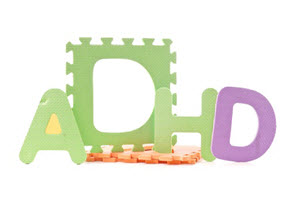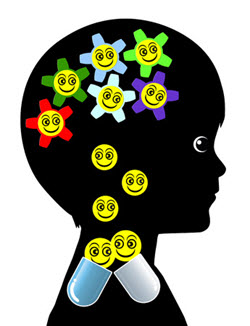 ADHD, with its attendant cognitive deficits, disrupts executive functioning in daily school activities, as well as activities at home or at play. Deficient executive functioning manifests as problems with self-restraint, managing time, motivation, organization, problem-solving and emotional self-regulation.
ADHD, with its attendant cognitive deficits, disrupts executive functioning in daily school activities, as well as activities at home or at play. Deficient executive functioning manifests as problems with self-restraint, managing time, motivation, organization, problem-solving and emotional self-regulation.
On average, about 60 percent of children and teens diagnosed with ADHD are taking medication to manage symptoms. Uniformly, these medications make life less hard for these kids, are very effective and generate noticeable, positive effects often within hours of administration. Regardless of the medication class employed, these dr
ugs must be used every day and will control symptoms only as long as they are taken. There are no long-term lasting effects once the drugs are stopped, and ceasing medication use, more often than not, ushers in a return of symptoms that look very similar to those before medication treatment was initiated.
The most widely prescribed class of medication for managing ADHD symptoms is the psychostimulants. All of the psychostimulants activate the neurotransmitter dopamine – and to some extent norepinephrine also – in the frontal cortex area of the brain, increasing communication between nerve cells that regulate attention and behavior. Norepinephrine activation helps improve attention and focus; dopamine activation improves and lengthens attention span, aids with distractibility and helps manage excessive movement manifesting as hyperactivity and impulsivity.
Two types of stimulants are routinely prescribed in the United States: methylphenidate (MPH) and amphetamine (AMP). These 2 drug categories are delivered into the body, eventually reaching the brain through any one of 5 methods – which differ primarily in how long they maintain serum levels within these systems. The 5 delivery systems embody the letter “P” – pills, pump, pellets, patch and pro-drug.
PILLS
In pill formulation, MPH and AMP are absorbed rapidly into the bloodstream, usually within 30 minutes after administration. Peak serum levels are attained within 60-90 minutes and help maintain symptom control for 2-3 hours. I am a big fan of immediate-release preparations when it comes to efficacy, but symptom management requires dosing at least three times per day, making them inconvenient – fostering missed doses because of forgetfulness. Another complication is getting the midday dose(s) to school, which can be quite cumbersome. Brand names include: Ritalin, Focalin, Dexedrine and Adderall.
PUMP
Pump technology was truly innovative and novel when it came to advancing medication development in ADHD. This is referred to as OROS – osmotic-release oral system for delivering active ingredient into the body and keeping it in the blood stream longer. The pump system is available only as MPH and the brand name is Concerta. After ingestion of OROS MPH, an immediate release of methylphenidate occurs in the outer covering of the tablet, followed by a progressive 6-8-hour release through the action of the osmotic pump. Maybe the best way to describe Concerta is that it is a once-daily preparation that mimics three times per day dosing with immediate release MPH, but without the loss of efficacy common to regular Ritalin because of its short duration of action. For you prescribers out there please note: I’ve come to believe that this pump system takes a while to get circulating when a dose is administered in the morning, thus yielding better results for the child later in the day. So if the child needs greater symptom control in the afternoon rather than the morning hours, Concerta preparations are your best bet. Also, I find that the OROS delivery system is better at improving cognitive function (working memory, attention) than other delivery systems discussed in this article.
PELLETS
 Remember the cold medicine Contac? It was one of the very first time-release products for managing the symptoms of the common cold. This time-release system had to be modified to accommodate MPH and AMP, eventually leading to the emergence of a pellet system for both of these stimulants. The active ingredient of the drug is coated little beads which dissolve immediately after swallowed, while others dissolve one hour later, two hours later, etc., thus the term “time-released.” Active ingredient activation is thus gradual and absorbed into the blood steam over a span of approximately 8 hours. The pellet delivery system has the additional advantage for those who can’t or would rather not swallow the capsule containing the pellets in that the capsule can be opened and the pellets sprinkled on food (applesauce, yogurt). Brand name pellet preparations that you may have heard of include: Ritalin LA, Focalin XR, Metadate CD and Adderall XR. Again for prescribers: The pellet product design yields higher plasma concentrations than OROS MPH over the first 6 hours after administration, followed by a more rapid decline. So if the child needs greater symptom control in the morning, use the pellets, rather than Concerta. A final point: It is a myth that either the pump system or the pellet system provide 12 hours of symptom coverage, it’s actually closer to 7-8 hours.
Remember the cold medicine Contac? It was one of the very first time-release products for managing the symptoms of the common cold. This time-release system had to be modified to accommodate MPH and AMP, eventually leading to the emergence of a pellet system for both of these stimulants. The active ingredient of the drug is coated little beads which dissolve immediately after swallowed, while others dissolve one hour later, two hours later, etc., thus the term “time-released.” Active ingredient activation is thus gradual and absorbed into the blood steam over a span of approximately 8 hours. The pellet delivery system has the additional advantage for those who can’t or would rather not swallow the capsule containing the pellets in that the capsule can be opened and the pellets sprinkled on food (applesauce, yogurt). Brand name pellet preparations that you may have heard of include: Ritalin LA, Focalin XR, Metadate CD and Adderall XR. Again for prescribers: The pellet product design yields higher plasma concentrations than OROS MPH over the first 6 hours after administration, followed by a more rapid decline. So if the child needs greater symptom control in the morning, use the pellets, rather than Concerta. A final point: It is a myth that either the pump system or the pellet system provide 12 hours of symptom coverage, it’s actually closer to 7-8 hours.
PATCH
The only patch formulation on the U.S. market has gone by the brand name Daytrana for years now. Daytrana’s active ingredient is MPH, so it is essentially a long-acting Ritalin-type preparation which is applied to the skin. The patch is best applied to a flat surface area such as the upper arm, the back of the shoulder or the buttocks. The patch is generally applied in the early morning and removed at 5pm to permit the drug remaining in the body to be broken down and eliminated without adversely affecting sleep onset. An advantage of the patch is that if the child has a shorter school day, the patch can be remover earlier – obviously impossible to do with a drug that needs to be swallowed. Disadvantages are remembering to remove the patch several hours before sleep and the possibility of developing a skin rash at the application site. And although rare, some children have taken to chewing the patch to obtain the active ingredient orally, while others “trade” the patch to a schoolmate for something else they’d rather have.
PRO-DRUG
So what is a pro-drug? A pro-drug is a “drug waiting to become a drug.” The only pro-drug in the ADHD space is Vyvanse – and I like this drug. Its properties are similar to those of Adderall XR, but with an important exception. Adderall XR can be crushed and inhaled and the powder from other pills or the crushed beads from the pellet systems can be liquefied and injected into a vein. Vyvanse, which is AMP, on the other hand, remains inactive until it is swallowed. After swallowing and absorption in the stomach, it converts to its active ingredient, dAMP, and then goes to work in the blood stream. Thus this delivery system greatly reduces the abuse potential of this form of AMP. Again, 12-hour symptom coverage I find to be exaggerated; it’s closer to 8-10 hours.
The most common side effects experienced when taking a stimulant (MPH or AMP) are listed in order of likelihood of occurrence.
- Insomnia
- Loss of appetite
- Weight loss
- Headaches
- Nausea
- Anxiety
- Irritability
- Motor tics
- Muscle tension
Both MPH and AMP have abuse potential because they increase dopamine in the brain’s pleasure centers. But abuse is a rare phenomenon when ADHD medications are ingested in pill or capsule form and swallowed.
A final point: As a clinician, if you’ve diagnosed ADHD in a child or adolescent and are confident in this, consider starting treatment with medication early. The medications discussed in this piece can reduce the high price in psychic pain, loss of educational opportunity and distressed relationships experienced by so many of these youth, giving them a better chance of growing into a healthy and thoughtful adult.
Attribution Statement:
Joe Wegmann is a licensed pharmacist & clinical social worker has presented psychopharmacology seminars to over 10,000 healthcare professionals in 46 states, and maintains an active psychotherapy practice specializing in the treatment of depression and anxiety. He is the author of Psychopharmacology: Straight Talk on Mental Health Medications, published by PESI, Inc.
To learn more about Joe’s programs, visit the Programs section of this website or contribute a question for Joe to answer in a future article: joe@thepharmatherapist.com.